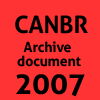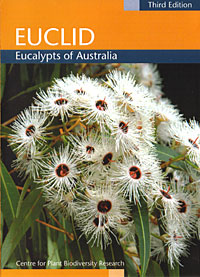 Document relating to the history of the CANBR, by Andrew Slee, 2007
Document relating to the history of the CANBR, by Andrew Slee, 2007
EUCLID
a project designed to solve the problem of accurate eucalypt identification
A brief history of EUCLID
The people involved in EUCLID were Ian Brooker, project leader until 2002, Isobel Crawford who worked on the original “demo-model” in the early 1990s, Andrew Slee and John Connors who between them coded all species, Siobhan Duffy the graphic designer and computer enthusiast, and Judy West, Director of the Centre for Plant Biodiversity Research, who initiated the project and oversaw it, raised money and trusted us to do it well. Funding came from two sources – CSIRO Plant Industry under successive chiefs Jim Peacock and Jeremy Burdon, and also from 1996 to 2002 from the Bushcare program of the Australian Government Department of Environment and Heritage.
Identifying eucalypts using a key
In the on-line Oxford English Dictionary one definition of a Key is “That which serves to open up, disclose, or explain what is unknown, mysterious, or obscure; a solution or explanation.”
In botany until now the use of an identification key has meant a dichotomous key, where a choice between one piece of information and another leads in different directions to different conclusions.
The need for a new method of identifying or keying-out eucalypts to species level was obvious to any botany student who tried to use the dichotomous keys found in field guides such as those of Brooker & Kleinig, or in flora accounts like Chippendale’s 1988 “Flora of Australia volume 19, Eucalyptus and Angophora”. With dichotomous keys printed in books the user generally comes to a full stop before complete identification can be made because some vital piece of information is not available on the specimen to hand. The plant may lack buds at that time and only have fruit, or vice versa, or juvenile leaves cannot be found, or the tree may have developed reproductive parts precociously before rough bark characteristics are fully developed.
Two things were needed to get around this difficulty in using keys. Firstly a keying system that enabled the user to use any character available on the specimen in any sequence – a system where you could pick and choose the characters, rather than using those dictated by the dichotomous, written, fixed pathway key in the book in front of you. Secondly the user would need to become familiar with more features of the plant, their reliability, their plasticity. In other words how much information you have available, and how you use that information.
These two things meant that computers were the way to go. In 1991 software was already available that enabled the use of random character selection as a method to filter out species that did not match. Computers were also rapidly changing at this time with great increases in both memory, and hard disk space. This meant the use of large numbers of images and large quantities of text were possible which solved the second difficulty – features of the plants could be adequately illustrated quite cheaply, variation could be described, full descriptions could be presented for all species for the first time ever – descriptions from the cotyledons to the crown leaves, including newish characters like internal bud features which have a high level of reliability, detailed descriptions of gumnuts and seed, again of high reliability, early seedling leaf arrangement, what field-grown ground-level coppice looks like, adult leaf features including major and minor leaf vein patterns etc. It is cheaper to store and display images and text on a computer than it is to present them in a book. So an improved eucalypt identification key using a computer seemed feasible.
DELTA
We decided to build a trial key to the species occurring in eastern Victoria using software called DELTA. We would need a list of species names and a list of features or characters which could be scored for each of the species, including both presence/absence type characters and numerical length and breadth type characters. This “demo model” key to ca 70 species enabled us to refine our Character list. It was important to fix this list as much as possible very early on in the project as any additional characters added later would need to be “backfilled” for every species previously dealt with. It is a tribute to the project leader, Ian Brooker with his enormous knowledge of eucalypts, that the list of characters and their states in fact remained little changed throughout the following 15 years of key construction by what became the EUCLID team.
DELTA proved cumbersome to use for both building a key and making identifications as a user. DELTA was being widely used in Australia by entomologists and botanists for various purposes but pressure was building for something better for general identification key construction. The “demo model” showed that it could be done and how long it might take but we would need friendly software with good on-screen presentation.
LUCID
Botanist Kevin Thiele, based then at Martin’s Creek in east Gippsland, together with programmers from University of Queensland developed a new Windows based package which came in two parts called the LUCID Builder, for key construction, and the LUCID Player, for identification. The first draft of “EUCLID Eucalypts of South-eastern Australia” was shifted across from the DELTA software to the LUCID software in 1996, with some difficulty. We felt we were getting somewhere. Using the LUCID Builder we could easily modify any species scoring, add new species, delete species and rebuild the key all on the desktop very quickly, resulting in a new key in the LUCID Player which could then be immediately tested with fresh specimens.
Having a list of 120 characters to aid in identification was only half the battle. For any species in the key each of these 120 characters had to be scored from specimens and the data added to the LUCID Builder. We scored character states from the 65,000 eucalypt herbarium specimens at the Australian National Herbarium, some from other herbaria also, and from fresh material in the field. Seedlings were grown for most species, and always from well vouchered seed. The key was easy to build once the data was entered. The software was a breeze to use. Writing descriptions, taking photos and attaching images proceeded well.
EUCLID
Having built a key to the 310 eucalypts of New South Wales, Victoria, Tasmania and the wetter, south-eastern parts of South Australia, we decided to publish it to see how it was received. The name EUCLID, compounded from EUCaLypt and IDentification by management gurus, has nothing to do with a mathematician from ancient Alexandria, and wasn’t the choice of the authors. The first edition of “EUCLID Eucalypts of South-eastern Australia” was published in 1997 on CD, reprinted in 1998, and re-issued as a revised edition in 2000. The production of this revised edition illustrated three points about electronic identification packages. Firstly they are easy to revise – you can add or remove species, alter text, add or replace images quite simply. Secondly you can adapt to changes in currently available computer operating systems. Thirdly, interactive keys are popular.
 |
 |
Concurrently with the preparation of the revised edition the EUCLID team embarked on an exciting venture – incorporating the species from the mostly drier south-western part of the continent. The area from Balladonia to Shark Bay and south to the shores of the Southern Ocean is mind-blowing for the diversity of its eucalypts. Going west meant doubling the area covered by EUCLID and more than doubling the number of species. It meant getting to know the species in the field and herbarium plus seemingly endless photography still using photographic film. The digital camera revolution hadn’t quite hit us at that stage. With the revised edition and the addition of the western species under way we expanded the EUCLID team to include a graphic designer, Siobhan Duffy, a move which led to greatly improved presentation of the text and images, involving the then relatively new HTML format with all its associated linkages between virtual pages and images. We could link between words and glossary for example, between related species, between text and images in the character list etc.
“EUCLID Eucalypts of Southern Australia” was published in October 2002 on 2 CDs and covered 690 species and subspecies in the genera Eucalyptus and Angophora. It was designed to run with the key loaded onto the hard-disk, and the images and text, now presented as “fact sheets”, being referenced from the second CD loaded in the CD drive. Not ideal but considering the amount of space on common hard drives at that time probably the only way to go.
We immediately started work on the final stage, adding the tropical and sub-tropical species. Ian Brooker had recently retired, so it was up to John Connors and myself together with Siobhan to put it together. We drew a line through July 2005 and refused to incorporate newly published northern species after that date. Botanists in southern Australia had been busy in the interval since 2002 and we also had to consider anything new there. Management at CSIRO was getting sick of us always wanting to do field work, and broadly hinted at possible redeployment. We had no external funding by this stage. With eucalypts you must do field work to come to an understanding of the morphology of the species, there is no other way. You must also collect widely to adequately sample variation and the seasonal availability of buds and fruit is more exaggerated in the tropics. On a practical note, using digital cameras speeded things up when we did get to go into the field, but distances seem longer in northern Australia and a lot of species are not doing much in the dry season, some in fact are deciduous.
Much of northern Australia has savannah woodland dominated by bloodwoods and ghost gums which meant the hitherto unaddressed problem of generic name usage came to the fore. Do we go with history and continue to use the generic name Eucalyptus for bloodwoods and ghost gums or do we start to use the name Corymbia? We took the latter course, following a usage pattern now largely entrenched in northern Australia by anyone dealing with these plants and using formal names.
“EUCLID Eucalypts of Australia” covering 894 species and subspecies in the genera Eucalyptus, Corymbia and Angophora was published in October 2006, on DVD, with the option of loading the entire package onto the hard disk (if you have 2.2Gb to spare) or running it from the DVD.
EUCLID is very much a pragmatic account of the species using generally easily understood features of the plants to separate them. It won’t satisfy everyone. We tend to be “lumpers” rather than “splitters” at the species level. The introductory essay “Learn about Eucalypts”, accessible from the front page, is worth reading, and now includes a short section on the latest molecular phylogeny of the group we call the eucalypts.
Accurate identification can be easy and quick, but on occasions you may need to revisit plants in the field and collect those elusive buds, fruit, or juvenile leaves, or maybe grow seedlings to clarify differences between closely related species. Don’t treat this as a chore but see it as further exploration of the most fascinating group of plants on the planet. Hopefully EUCLID can occasionally inspire you to go out and look more closely at leaves, buds and flowers on gum trees - in parks, gardens, arboretums, or best of all, in the wild.
Andrew Slee
Australian National Herbarium
2007
![An Australian Government Initiative [logo]](/images/austgovt_canbr_90px.gif)
